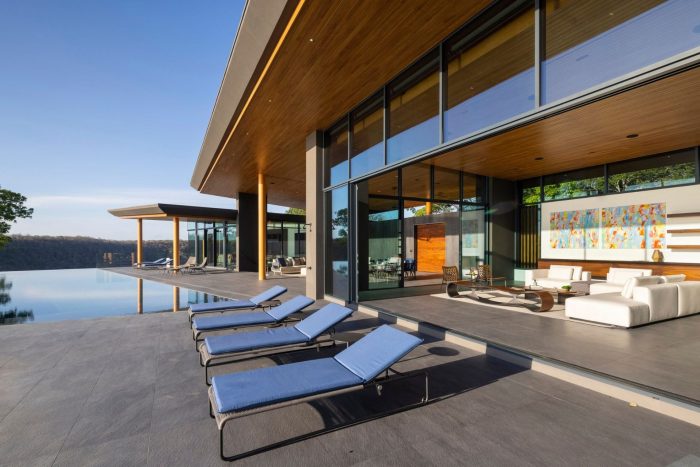As the spotlight shines on the Best architecture firms for luxury residential projects, readers are invited into a realm of expertise and creativity, promising a journey filled with valuable insights and unique perspectives.
The following paragraph will delve into the intricacies of this specialized field, offering a comprehensive understanding of what sets these firms apart.
Researching the Top Architecture Firms

When researching the top architecture firms specializing in luxury residential projects, it is important to consider various factors that set them apart. These firms are known for their exceptional design creativity, attention to detail, and ability to seamlessly blend functionality with aesthetics.
Characteristics of Top Architecture Firms
- Exceptional design creativity and innovation
- Attention to detail and craftsmanship
- Proven track record of successful luxury residential projects
- Strong reputation and positive client feedback
- Extensive experience in working on high-end residential properties
Renowned Architecture Firms for Luxury Residential Design
- Foster + Partners - known for their iconic and innovative luxury residential projects
- Richard Meier & Partners Architects - recognized for their timeless and elegant designs
- Shigeru Ban Architects - celebrated for their sustainable and unique luxury residential creations
Importance of Reputation and Experience
Choosing an architecture firm for luxury projects based on reputation and experience is crucial. A firm's reputation reflects its reliability and quality of work, while experience ensures they have the knowledge and expertise to handle complex luxury projects effectively.
Architectural Styles in Luxury Residential Projects
- Modern and minimalist design with clean lines and open spaces
- Traditional and classical architecture with intricate details and craftsmanship
- Contemporary and innovative designs incorporating new materials and technologies
Design Approach and Philosophy

When it comes to luxury residential projects, leading architecture firms often follow distinct design philosophies that set them apart in the industry. These firms prioritize creating bespoke, high-end spaces that cater to the unique needs and preferences of their clients.
Let's delve into the key factors that influence their design approach and how they balance aesthetics with functionality in luxury residential designs.
Key Factors Influencing Design Approach
- Client's Vision: Architecture firms prioritize understanding the client's vision and lifestyle to create personalized spaces that reflect their tastes and aspirations.
- Location and Surroundings: Incorporating elements of the surrounding environment and optimizing views play a crucial role in designing luxury homes that seamlessly blend with their surroundings.
- Quality of Materials: The use of premium materials and finishes is essential in creating a luxurious ambiance and ensuring longevity in design.
- Craftsmanship and Attention to Detail: Firms focus on intricate details and craftsmanship to elevate the overall design and create a sense of luxury.
Balance of Aesthetics and Functionality
- Integration of Technology: Architectural firms seamlessly integrate smart technologies and innovative solutions to enhance the functionality of luxury residential spaces.
- Spatial Planning: Emphasis is placed on optimizing spatial layouts to ensure a harmonious flow between different areas while maintaining a visually appealing aesthetic.
- Customization and Personalization: Tailoring designs to the specific needs and preferences of clients allows for a perfect balance between aesthetics and functionality.
Role of Sustainability and Eco-friendliness
- Green Building Practices: Many architecture firms are incorporating sustainable design principles and eco-friendly materials to reduce the environmental impact of luxury residential projects.
- Energy Efficiency: Implementing energy-efficient systems and technologies not only lowers operational costs but also aligns with the growing trend towards sustainable living in luxury homes.
- Wellness Design: Integrating wellness-oriented design elements such as natural lighting, indoor air quality, and biophilic design principles contribute to a healthier and more sustainable living environment.
Collaborations and Partnerships
Collaborations with interior designers, landscape architects, and other professionals play a crucial role in the success of luxury residential projects. These partnerships bring together diverse expertise and perspectives to create truly exceptional living spaces that cater to the unique needs and preferences of high-end clients.
Successful Partnerships between Architecture Firms and Interior Designers
One example of a successful collaboration between an architecture firm and an interior designer is the partnership between Zaha Hadid Architects and Kelly Wearstler for a luxury residential project in Miami. The innovative architectural design by Zaha Hadid Architects was seamlessly complemented by Kelly Wearstler's exquisite interior design, resulting in a harmonious blend of form and function.
Enhancing Design and Functionality through Collaborations
- Creative synergy: Collaborations bring together different design sensibilities and expertise, resulting in innovative and holistic design solutions that elevate the overall aesthetic appeal of luxury homes.
- Attention to detail: Interior designers, landscape architects, and other professionals pay meticulous attention to detail, ensuring that every aspect of the project is thoughtfully curated to create a cohesive and luxurious living environment.
- Seamless integration: By working closely together, collaborators ensure that the architectural design seamlessly integrates with the interior spaces, landscaping, and other elements, enhancing the functionality and flow of the residence.
Impact of Technology and Innovation on Collaborations
Advancements in technology, such as Building Information Modeling (BIM) and Virtual Reality (VR), have revolutionized the way architecture firms collaborate with interior designers and other professionals. These tools allow for real-time collaboration, visualization of design concepts, and efficient communication, leading to more streamlined and effective project delivery.
Project Showcase and Case Studies
In the world of luxury residential architecture, showcasing specific projects and case studies is essential to understanding the design elements, materials, and overall aesthetics that top architecture firms bring to their work. It also allows us to explore the successful execution of challenging architectural designs and the importance of customization in luxury homes.
Luxury Residential Project 1: Villa Serenity
Villa Serenity, designed by XYZ Architects, is a stunning example of modern luxury living. The sleek lines, expansive glass walls, and use of high-end materials like marble and wood create a sense of sophistication and elegance. The seamless integration of indoor and outdoor spaces, along with the breathtaking views of the surrounding landscape, make this home a true sanctuary.
Luxury Residential Project 2: Oceanfront Oasis
The Oceanfront Oasis, a project by ABC Design Studio, showcases the successful execution of a challenging architectural design. The firm's innovative use of sustainable materials, such as recycled wood and glass, combined with cutting-edge technology, resulted in a home that not only meets the highest standards of luxury but also prioritizes environmental sustainability.
Customization and Personalization in Luxury Residential Architecture
- Personalization plays a crucial role in luxury residential architecture, as it allows homeowners to create a space that truly reflects their unique lifestyle and tastes.
- Top architecture firms often collaborate closely with clients to understand their preferences, creating bespoke designs that cater to their specific needs and desires.
- Customization can range from selecting materials and finishes to designing unique architectural features that set the home apart from others.
Project Management Processes for Luxury Residential Projects
- Architecture firms handling luxury residential projects follow meticulous project management processes to ensure that every detail is executed flawlessly.
- This includes thorough planning, budgeting, scheduling, and coordination of various stakeholders, such as contractors, suppliers, and interior designers.
- Regular site visits, quality control measures, and effective communication are also essential components of project management in luxury residential architecture.
Concluding Remarks
In conclusion, the world of luxury residential architecture is a captivating blend of innovation, collaboration, and meticulous attention to detail. Through the lens of top architecture firms, the beauty of design and functionality harmonize to create truly exceptional living spaces that redefine luxury living.
FAQ Explained
What criteria should I consider when selecting a top architecture firm for a luxury residential project?
When choosing an architecture firm for a luxury residential project, factors such as reputation, experience, design philosophy, and past projects should be carefully evaluated to ensure the best outcome.
How do architecture firms balance aesthetics and functionality in luxury residential designs?
Leading architecture firms achieve a balance between aesthetics and functionality by prioritizing client needs, incorporating innovative design solutions, and paying attention to every detail of the project.
Why is collaboration with interior designers and other professionals important in luxury residential projects?
Collaborations with interior designers, landscape architects, and other professionals are crucial in luxury residential projects to ensure a cohesive design approach, seamless integration of various elements, and a harmonious living environment.
What role does sustainability play in modern luxury residential architecture?
Sustainability and eco-friendliness are integral aspects of modern luxury residential architecture, with architecture firms increasingly incorporating green building practices, energy-efficient solutions, and environmentally conscious design elements into their projects.












